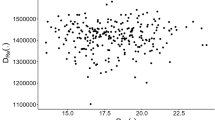Abstract
Synthetic aperture magnetometry (SAM) is a powerful MEG source localization method to analyze evoked as well as induced brain activity. To gain structural information of the underlying sources, especially in group studies, individual magnetic resonance images (MRI) are required for co-registration. During the last few years, the relevance of MEG measurements on understanding the pathophysiology of different diseases has noticeable increased. Unfortunately, especially in patients and small children, structural MRI scans cannot always be performed. Therefore, we developed a new method for group analysis of SAM results without requiring structural MRI data that derives its geometrical information from the individual volume conductor model constructed for the SAM analysis. The normalization procedure is fast, easy to implement and integrates seamlessly into an existing landmark based MEG-MRI co-registration procedure. This new method was evaluated on different simulated points as well as on a pneumatic index finger stimulation paradigm analyzed with SAM. Compared with an established MRI-based normalization procedure (SPM2) the new method shows only minor errors in single subject results as well as in group analysis. The mean difference between the two methods was about 4 mm for the simulated as well as for finger stimulation data. The variation between individual subjects was generally higher than the error induced by the missing MRIs. The method presented here is therefore sufficient for most MEG group studies. It allows accomplishing MEG studies with subject groups where MRI measurements cannot be performed.




Similar content being viewed by others
References
Buchner H, Adams L, Muller A, Ludwig I, Knepper A, Thron A et al (1995) Somatotopy of human hand somatosensory cortex revealed by dipole source analysis of early somatosensory evoked potentials and 3D-NMR tomography. Electroencephalogr Clin Neurophysiol 96:121–134
Chau W, McIntosh AR, Robinson SE, Schulz M, Pantev C (2004) Improving permutation test power for group analysis of spatially filtered MEG data. Neuroimage 23:983–996
Cheyne D, Bakhtazad L, Gaetz W (2006) Spatiotemporal mapping of cortical activity accompanying voluntary movements using an event-related beamforming approach. Hum Brain Mapp 27:213–229
De Wilde JP, Rivers AW, Price DL (2005) A review of the current use of magnetic resonance imaging in pregnancy and safety implications for the fetus. Prog Biophys Mol Biol 87:335–353
Dewey M, Schink T, Dewey CF (2007) Frequency of referral of patients with safety-related contraindications to magnetic resonance imaging. Eur J Radiol 63:124–127
Druschky K, Kaltenhauser M, Hummel C, Druschky A, Pauli E, Huk WJ et al (2002) Somatotopic organization of the ventral and dorsal finger surface representations in human primary sensory cortex evaluated by magnetoencephalography. Neuroimage 15:182–189
Dziewas R, Soros P, Ishii R, Chau W, Henningsen H, Ringelstein EB et al (2003) Neuroimaging evidence for cortical involvement in the preparation and in the act of swallowing. Neuroimage 20:135–144
Gaetz W, Cheyne D (2006) Localization of sensorimotor cortical rhythms induced by tactile stimulation using spatially filtered MEG. Neuroimage 30:899–908
Hirata M, Kato A, Taniguchi M, Ninomiya H, Cheyne D, Robinson SE et al (2002) Frequency-dependent spatial distribution of human somatosensory evoked neuromagnetic fields. Neurosci Lett 318:73–76
Hollenhorst J, Munte S, Friedrich L, Heine J, Leuwer M, Becker H et al (2001) Using intranasal midazolam spray to prevent claustrophobia induced by MR imaging. AJR Am J Roentgenol 176:865–868
Holliday IE, Barnes GR, Hillebrand A, Singh KD (2003) Accuracy and applications of group MEG studies using cortical source locations estimated from participants’ scalp surfaces. Hum Brain Mapp 20:142–147
Huang MX, Mosher JC, Leahy RM (1999) A sensor-weighted overlapping-sphere head model and exhaustive head model comparison for MEG. Phys Med Biol 44:423–440
Knowlton RC, Laxer KD, Aminoff MJ, Roberts TP, Wong ST, Rowley HA (1997) Magnetoencephalography in partial epilepsy: clinical yield and localization accuracy. Ann Neurol 42:622–631
McIsaac HK, Thordarson DS, Shafran R, Rachman S, Poole G (1998) Claustrophobia and the magnetic resonance imaging procedure. J Behav Med 21:255–268
Mertens M, Lutkenhoner B (2000) Efficient neuromagnetic determination of landmarks in the somatosensory cortex. Clin Neurophysiol 111:1478–1487
Nichols TE, Holmes AP (2002) Nonparametric permutation tests for functional neuroimaging: a primer with examples. Hum Brain Mapp 15:1–25
Overduin SA, Servos P (2004) Distributed digit somatotopy in primary somatosensory cortex. Neuroimage 23:462–472
Quirk ME, Letendre AJ, Ciottone RA, Lingley JF (1989) Anxiety in patients undergoing MR imaging. Radiology 170:463–466
Robinson SE, Vrba J (1999) Functional neuroimaging by synthetic aperture magnetometry (SAM). In: Yoshimoto T, Kotani M, Kuruki S, Karibe H, Nakasato N (eds) Recent advances in biomagnetism. Tohoku University Press, Sendai
Robinson SE, Vrba J (2004) Cleaning fetal MEG using a beamformer search for the optimal forward model. Neurol Clin Neurophysiol 2004:73
Schulz M, Chau W, Graham SJ, McIntosh AR, Ross B, Ishii R et al (2004) An integrative MEG-fMRI study of the primary somatosensory cortex using cross-modal correspondence analysis. Neuroimage 22:120–133
Sekihara K, Sahani M, Nagarajan SS (2005) Localization bias and spatial resolution of adaptive and non-adaptive spatial filters for MEG source reconstruction. Neuroimage 25:1056–1067
Taniguchi M, Kato A, Fujita N, Hirata M, Tanaka H, Kihara T et al (2000) Movement-related desynchronization of the cerebral cortex studied with spatially filtered magnetoencephalography. Neuroimage 12:298–306
Van Veen BD, Buckley KM (1988) Beamforming: a versatile approach to spatial filtering. IEEE Trans Acoust 5:4–24
Vrba J, Robinson SE (2001) Signal processing in magnetoencephalography. Methods 25:249–271
Woodthorpe C, Trigg A, Alison G, Sury M (2007) Nurse led sedation for paediatric MRI: progress and issues. Paediatr Nurs 19:14–18
Acknowledgment
This study was supported by DFG (PA-392/9-2) and (JU 445/5-1).
Author information
Authors and Affiliations
Corresponding author
Additional information
O. Steinstraeter and I. K. Teismann contributed equally to this work.
Rights and permissions
About this article
Cite this article
Steinstraeter, O., Teismann, I.K., Wollbrink, A. et al. Local sphere-based co-registration for SAM group analysis in subjects without individual MRI. Exp Brain Res 193, 387–396 (2009). https://doi.org/10.1007/s00221-008-1634-z
Received:
Accepted:
Published:
Issue Date:
DOI: https://doi.org/10.1007/s00221-008-1634-z




